Live Steamers and Traction?
***
One of the senior members of the Southern California Traction Club is also a member of the Southern California Live Steamers (SCLS), a club that has been in existence since 1948. Their purpose is to educate and promote interest in railroading by building and operating a miniature railroad facility. This non-profit organization runs miniature locomotives which pull trains of three to four cars filled with seated passengers. We expected to find locomotives powered by steam running when we visited their operating location in Wilson Park in Torrance, CA on Sunday, March 4th.
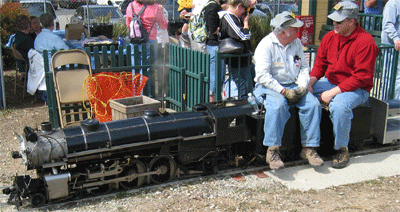
We also expected to find some miniature diesel electric locomotives powered by internal combustion engines. But we were surprised to find electric locomotives which were battery powered. We found two models of 1451 class Pacific Electric express box motors in different states of completion on this day. Since many HO scale models of these well known units exist, it was a pleasure to see these large size models here.
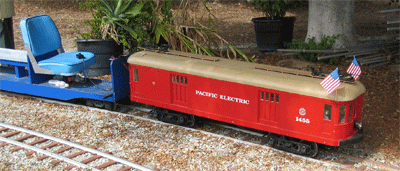
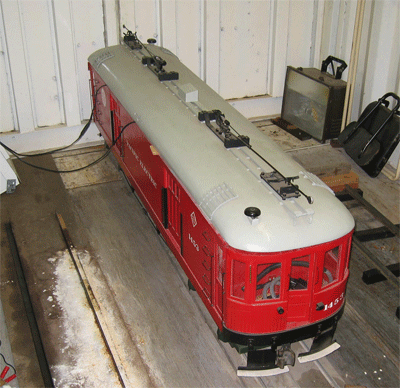
Just outside the entrance to the SCLS area, the body of Pacific Electric 4601 sits on a detached section of track.

This car is a sister to cars 314, 418 and 498 which are operable at the Orange Empire Railway Museum in Perris, CA but had its life cut short when it was involved in a head-on collision early in the morning on the Torrance line at 128th and Athens Way on October 19, 1946. It had the misfortune of hitting freight loco 1628 which was pulling a 13-car freight train. The motorman was killed as the entire vestibule end was crushed. Its motors went to a trailer which was also numbered 4601. Although the car was officially listed as scrapped, the car found its way to Wilson Park some years ago and slowly, renovation of the undamaged end is taking place.
____________________________________________________
More PCC Cars for San Francisco!
Early Saturday morning, March 10th, two more PCC cars arrived in San Francisco. Car 1080, adorned in 1944 Los Angeles Transit Lines (LATL) "fruit salad" colors along with Car 1071, in the colors of Twin Cities Rapid Transit (Minneapolis-Saint Paul) were unloaded from their trailers and towed into the Geneva facility. Car 1071 is shown in Geneva yard after being towed in by Melbourne 496.
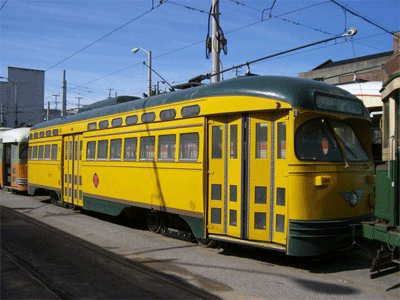
Car 1071 arrived accompanied by car 1080, which actually arrived for the second time, having initially been delivered in May 2006 without the interior upgrade. The next photo is of car 1080 while being test run in May 2006.
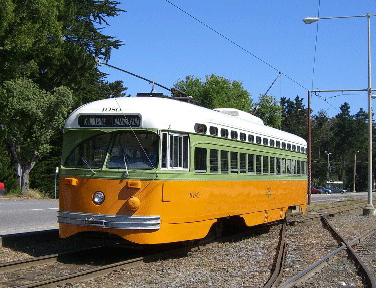
The final car of the eleven ex-Newark PCC cars arrived at Geneva on on March 26th. This car is dressed in Mexico City colors.
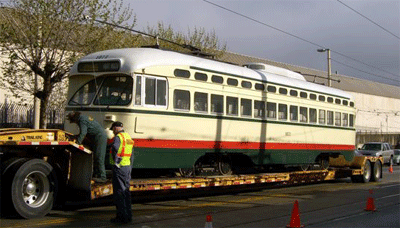
Car 1072, the last of the series 1070-1080 cars to be acquired and refurbished for F-line service, is shown above on the trailer just prior to being unloaded. In the next photo, the car is shown being towed (pushed) into Geneva yard.
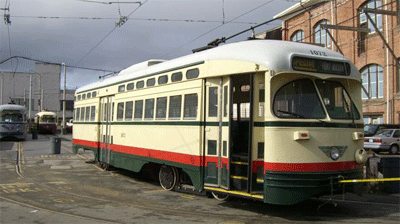
To the left of the car are cars 1070 (Newark) and 1075 (Toronto). For your trolley modelers, here is a rear view of car 1072.
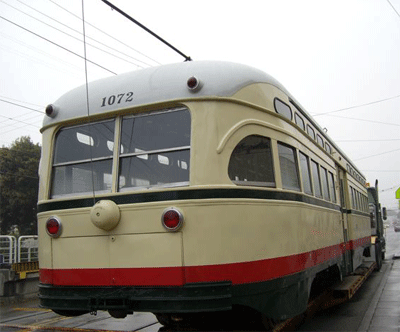
With the coming of the new T-Third Street Line and these new colorful PCC cars, San Francisco continues to outdo itself. So as soon as more operators can be trained and these new cars are checked out, more service can be added to the F-line.
[See Muni PCC, Column 2]
What's WRONG or RIGHT with the Hobby?
***
This subject has been debated for years and most likely will continue to be a topic of conversation as long as anyone runs model trains anywhere. The Times has entered our opinion into the state of Model Railroading from the traction modeler point of view many times. Our views have resulted in considerable dialogue with model railroaders, traction modelers and general train lovers over the years. One thing we have to conclude is that you can not look at what's WRONG with the hobby until you look at what's RIGHT with the hobby.
An interesting observation made by many modelers during conversations with our reporters was that the model railroading owes it's history to Joshua Cowen Lionel who was just making a moving storefront display. The point is that he was designing an item for public consumption. In doing this, he was looking for something to attract the attention of the general public. The general public, not train lovers, were the object of his attention. Since that time, the public has become much more sophisticated. It takes much more to attract the public today. All one has to do is watch how the companies compete for the best commercial at the annual Super Bowl. The bottom line is that a train running around in a circle with a string of lighted passenger cars or a lighted caboose is no longer an attraction. no matter how perfect the reproduction is. The hobby has gone as far as it can with those types of models. We are past the lighted searchlight cars, the missile launch cars and mechanically generated sounds and motion. Computers run almost every part of our daily lives. They run our cars, our phones, our television sets and most of our tools and appliances, so it is no surprise that Digital Command Control (DCC) and on-board sound and effects is available today and continues to attract attention. It is also no surprise that many old-timers are rejecting DCC just as they rejected plastic kits and in some cases, personal computers in general. It is no surprise, that the MTH Pennsylvania Railroad K-4 Pacific, with its 24-function capability, on-board sound and synchronized chuff 'n' puff is taking the hobby by storm. I am sure that if Union Pacific had not been showing their "butts" to the modelers via their "trademark" hooliganism, MTH might have made their first engine, UP 844 or maybe 3985. Both of these engines have had a lot more visibility in the last twenty years than any PRR K-4 and would have done a lot for the Union Pacific image. The Pennsylvania Railroad has a lot of fans but the railroad has been 'dead' for almost 40 years. Yet, the MTH K-4 is so fantastic that it is making a lot of new "Pennsy" fans. DCC and on-board sound attracts the public. It really does, when they get to see it. We noted some young women, in their late twenties, watching a demonstration of the MTH K-4 during the Christmas season and noted the same reaction is their eyes and body language that we saw years ago with Lionel Steam engines puffing smoke and the general public when they are told that those trolley cars of the Southern California Traction Club are REALLY getting power from those overhead wires. We seriously doubt that either of these two women had ever seen a live steam engine.
Embracing Digital Command Control requires the same change in mind-set that acquiring your first personal computer did. If you make the adjustment and get over the initial hump, it is much easier after that. Just as in the state of personal computers, technology will continue to advance or you get left behind. And fewer people will stay behind with you. So the decision is yours. It is so different to turn on your model railroad and listen to the sounds of real locomotives before you even move an engine. But now, before anything moves, your railroad room takes on the odor of a steam engine terminal in addition to the sounds. DCC and on-board sound is exactly what is RIGHT with the hobby. It is already attracting new modelers, young modelers who are not resistant to computers, but on the other hand are very familiar and comfortable with computer technology, hardware and software. These will be the type of modelers who will think of new ways to use computer technology in the pursuit of enjoyable model railroading and eventually they will make operating model trains in the DCC environment as simple as using DC (Analog) is today. Once upon a time, we controlled horsepower with reins, now it is pedals and a steering wheel. At one time, appliances were controlled with levers and knobs, now it is pushbuttons. The hobby is also slowly but surely moving in that direction. That is really what is RIGHT with it. In truth, there is nothing really WRONG with the hobby. Those hobbyists who refuse to to embrace this new and powerful enhancement to model train operation could first be merely pushed aside and then possibly forgotten about altogether. If there is a bright future for model railroading, DCC or its successor will be the nucleus of it.
_________________________________________
Pursuing DCC Operation as a trolley modeler!
***
After extolling the virtues of DCC, trying to bring that world into the trolley modeling is more frustrating than hanging overhead wire over a slip switch. Not only are there no ready-to-run trolleys, but there are no ready-to-run trolleys that are DCC ready and there are no model ready-to-run trolleys with DCC decoders. We have noticed more and more DCC being used at the East Penn Traction Club meets and we wanted to learn more. So to learn the virtues of DCC, we had to play steam railroad, so the Southern California Traction Club has taken a two-pronged approach.
First, one club member is building a layout in his home that will use the exact DCC control hardware and software that the club is using on the subway module and would use if and when the club converted completely to DCC operation. Second, the club will visit operating layouts using the same hardware and software.
Two SCTC members spent a day with the Golden Empire Historical and Modeling Society in Bakersfield, CA on Saturday, March 17th. Using an MTH PRR K-4s Pacific and a BLI PRR M-1a Mountain, we got to put these locomotives through all their paces using our own Digitrax DT400 controller. By the end of the day, we knew a lot more of the many pleasures and the few pitfalls of DCC operation . this is such a large layout that it took us at least one hour to get around the entire mainline route. Wouldn't an HO scale DCC/Sound PCC car be great? It isn't here yet but we will be ready when it does.
_________________________________________
Southern California Traction Club to appear at the South Coast Botanic Garden (Palos Verdes, CA)
***
The Southern California Traction Club will bring its 16' by 26' traction layout to the South Coast Traction Club on April 13 & 14 from 9:00 AM to 4:30 PM both days. This will be the eighth appearance of the club at this location but the first time that the club will be displaying in the main hall. The club started displaying in one of the 20' by 30' classrooms in 1997 when they displayed only five modules in an 'L' shape with two 11' legs.
The appearance at this show has always been a milestone for the club since the April 1997 show was the clubs very first public appearance. The following year, the club appeared with 11 modules arranged in an 'L' shape 15' by 19'. The club displayed their complete rectangular shaped layout for the first time at the April 2000 show. This appearance encompassed 20 modules in a display 19' by 22'. By the time of the April 2006 show, the club display was 16' by 22' and the room was getting too small. Now that the club had added the subway train module, the display is 16' by 26' and would not fit in the traditional location. So the club will appear in the main hall for the first time. this may be the time to come see the Southern California Traction Club layout, a layout where everything must run using powered overhead wires.
_________________________________________
[Muni PCC, from Column 1]
Also on March 26th, car 1056 (Kansas City Public Service), originally Philadelphia Transportation Co 2113, was rolled out after accident repairs were finally completed to the right front. The car had been seriously damaged by a negligent operator at Pier 13 during the Summer of 2001. Shop forces finally had enough time to devote to completing repairs. The car was expected to be back in service by the time you read this.
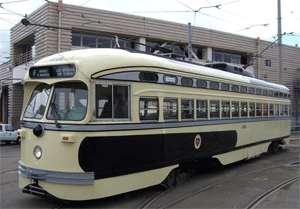
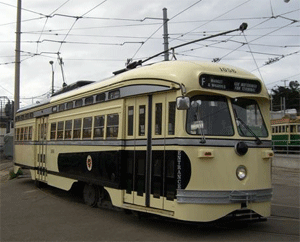
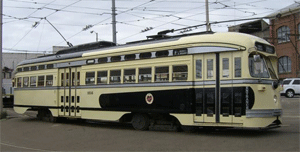
This is an opportune time for Muni to reintroduce this car to the public as the next Corgi 1:50 scale PCC replica is to be similar to this car.